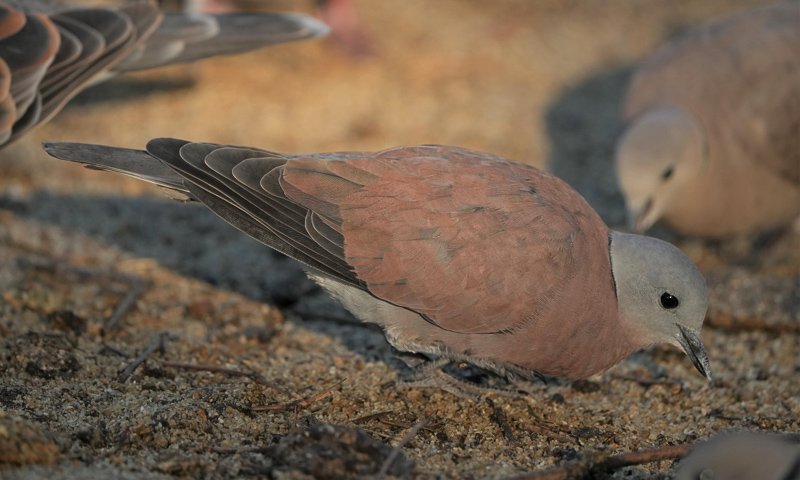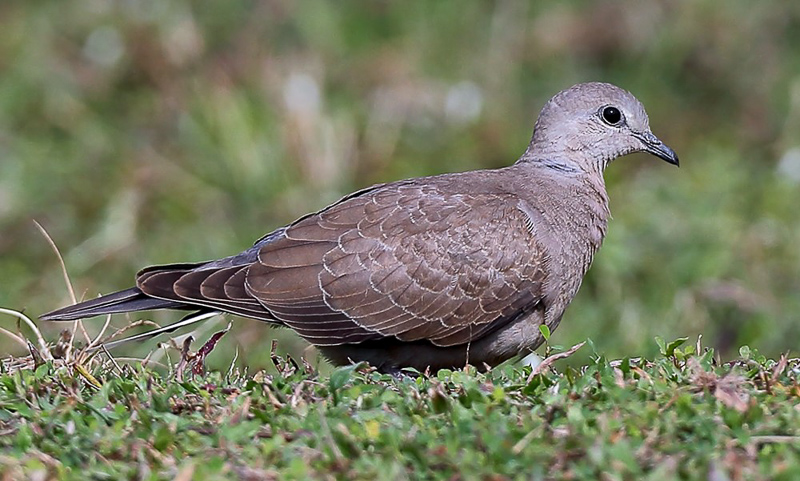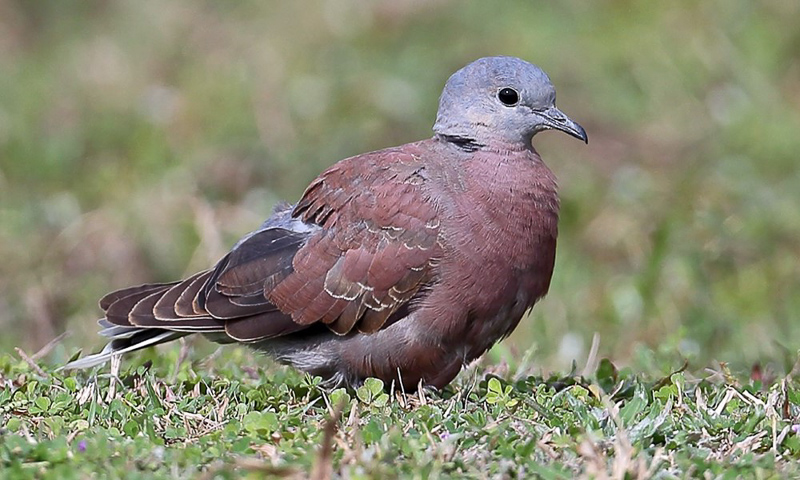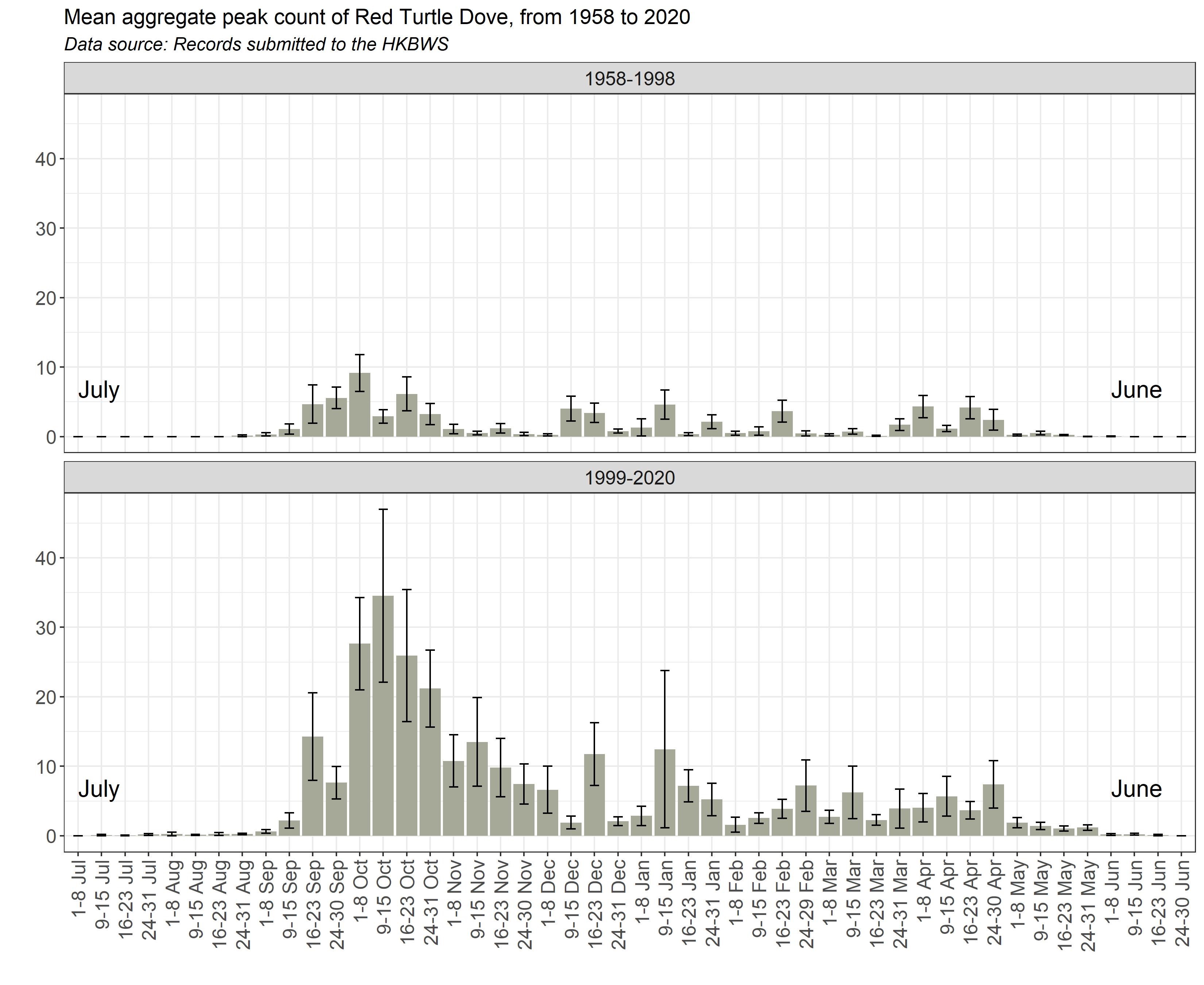Red Collared Dove Streptopelia tranquebarica 火斑鳩
Category I. A common passage migrant, especially in autumn, and scarce winter visitor, mainly to the Deep Bay area, with occasional summer records. Numbers appear to have increased in recent years and summer records have become more frequent, but there is no evidence that breeding has occurred.
IDENTIFICATION

Feb. 2023, Paul Leader. Adult male.
21-23cm. A small, rather compact and short-tailed dove, unusual amongst pigeons in being highly sexually dimorphic. The male is largely pinkish-red on most of both the upperparts and underparts, with a pale grey head and black hind collar, blackish flight feathers, a grey rump and uppertail, white undertail coverts and extensive white tips to the undertail and is unlikely to be confused with any other species.

May 2007, James Lam. Adult female.
The female is buffy-grey all over, except for a black hind collar. Its plumage is very similar to that of Collared Dove and is best distinguished by its smaller size and markedly shorter tail, the last feature being particularly useful in identifying single birds when size is difficult to judge.

Nov. 2013, Michelle and Peter Wong. Juvenile.
Juveniles are rather dull brown and lack the neck collar but have narrow pale fringes to the upperpart feathers.

Nov. 2013, Michelle and Peter Wong. First-winter.
This male still has pale fringes to unmoulted juvenile feathers.
VOCALISATIONS
Not reported vocalising in HK, but the recent increase in summer reports suggests this might happen. The song is a rather quiet and rapid, rhythmic cooing rattle.
DISTRIBUTION & HABITAT PREFERENCE
Red Collared Dove is largely confined to open country in the northwest New Territories where it occurs around fish ponds and other wetlands, active and abandoned farmland and the edges of villages. Carey et al. (2001) identified the Mong Tseng Peninsula, and especially an open pig farm there, as a stronghold, but in recent years it has been most regular and the largest numbers have been recorded in the San Tin and Lok Ma Chau area. Away from its core Deep Bay stronghold, Red Collared Dove is regularly recorded in small numbers in Long Valley, the Kam Tin area, with occasional reports from elsewhere in the New Territories including the airport. It is also frequently recorded in small numbers at migration watch points during passage periods; such reports are most frequent on Po Toi, but there are also records from Lung Kwu Tan, southwest Lantau and even Ho Man Tin and Mount Davis.
OCCURRENCE
As Figure 1 shows, Red Collared Dove is primarily a passage migrant, with the main passage periods typically extending from mid February to the end of April in spring, with a peak count at this season of 147 at Lok Ma Chau on 5 April 2021, In autumn it generally occurs from mid-September to early December with a peak count of 203, also at San Tin, on 14 October 2018. Both numbers occurring and passage periods vary from year to year though it is usually commoner in autumn than in spring. Passage is typically protracted in autumn with small numbers remaining through the winter, with the highest count in December and January being 69 on 7 December 2000.
Comparison of the pattern of records between the 1958 – 1998 and 1999 – 2020 periods (Figure 1) suggests that the timing of occurrence and the peak passage periods has shown little change, save that in the more recent period small numbers have occurred both later in spring (latest date, two at Lok Ma Chau MTRC Ecological Enhancement Area (EEA) on 21 June 2020) and earlier in autumn (earliest date, two at Stanley on 13 July 2016). The higher autumn numbers in the second of the two periods are at least in part due to increased observer activity.
Like Oriental Turtle Dove, the abundance of Red Collared Dove has fluctuated over the years. The earliest documented record is of a flock of 20 – 30 at Yuen Long on 4 October 1931 (Hutson 1931), who noted that it had ‘always been considered a rare visitor to HK’ only occurring whilst on ‘winter’ migration. That Red Collared Dove was a rare visitor at that time is, however, contradicted by Aymas (1931) who described it a a winter visitor occurring from the end of October to the beginning of March, sometimes occurring in flocks of two to three hundred birds. Similarly, Pereira (1938), referring to the winter of 1937-38, described it as very numerous, with flocks of 60 – 70 birds being a common sight at Kam Tin and Ha Tsuen whilst the rice was being harvested. Pereira was a hunter – indeed he described shooting half a dozen or more Red Collared Doves with a single shot and recorded his ‘bag’ for the season as comprising 184 birds – and it seems likely that he had a better understanding of the status of his quarry species than others.
Herklots (1953), primarily referring to his observations in the 1930s, described Red Turtle Dove as found throughout the New Territories (but not on HK Island) in winter (with an earliest date of 21 September and the main arrival in late October) and as occurring ‘often in flocks of some hundreds’ so it does seem that at that time it was a common winter visitor, most likely commoner than it is today. However, as is noted by Carey et al. (2001), a drastic decline appears to have taken place in the 1950s (a decline attributed to hunting in China during a time of terrible famine) and, indeed, it was not noted at all by Dove and Goodhart (1955) despite their observations being largely from the New Territories. Walker (1958) referred to only six seen on two dates, and, other than a flock of 20 in October 1959, no flocks of ten or more were seen until the 1970s, and it was not until October 1984 that flocks of 50 or more were seen again. The continued increase noted since the first Avifauna thus represents a partial return to its former status, though with the reduction in areas of suitable habitat, especially farmland, since that time it seems unlikely if it will ever become as common and widespread as it was in the 1930s.
BEHAVIOUR, FORAGING & DIET
Of HK’s four open country doves, Red Collared Dove is the species most likely to occur in large flocks, though sightings of single birds and small parties are not unusual, especially outside peak migration periods. If not observed in flight, it is usually to be seen foraging on the ground or perched on wires or trees – in the latter instance dead trees often seem to be favoured – and, like other doves, often appears to loaf on such perches for long periods.
Red Turtle Dove appears to be a granivore with most food obtained by foraging on the ground. Aymas (1931) described it foraging on loose grains of rice left behind after harvest, whilst the flocks at Mong Tseng in the 1980s fed on food scattered for pigs. At San Tin it is frequently seen eating bread stored for feeding fish and and at Lok Ma Chau EEA it readily forages on dried noodles provided as food for starlings (M. R. Leven pers obs).
BREEDING
There is no evidence that Red Collared Dove has ever bred in HK. However, the recent increase in summer reports suggest that breeding is a distinct possibility. In this regard, it is of note that Vaughan and Jones (1913) considered it to be a common resident species on the West River, though it seems that it is now a rather scarce species in southeast China (Lewthwaite 1996) and recent eBird records in Guangdong Province lie outside the midsummer period (eBird 2021).
RANGE & SYSTEMATICS
The native range of Red Collared Dove extends from Pakistanin the west, through India and southeast Asia east to the Philippines and south to Singapore. Feral populations have also become established on several islands in Indonesia (Baptista et al. 2020). In China, Red Collared Dove is widespread in the centre and south of the country north to Shaanxi and Shandong, with some records from the northeast (Liu and Chen 2021).
There are two subspecies, the taxon occurring in China, including HK, is S. t. humilis.
CONSERVATION STATUS
IUCN: Least Concern. Population trend decreasing.
Figure 1.

Aymas. (1931). Hong Kong Doves. Hong Kong Naturalist 2: 234-235. [Aymas was a pen-name of R.A. Pereira]
Baptista, L. F., P. W. Trail, H. M. Horblit, P. F. D. Boesman, and E. F. J. Garcia (2020). Red Collared-Dove (Streptopelia tranquebarica), version 1.0. In Birds of the World (J. del Hoyo, A. Elliott, J. Sargatal, D. A. Christie, and E. de Juana, Editors). Cornell Lab of Ornithology, Ithaca, NY, USA. https://doi.org/10.2173/bow.recdov1.01
Carey, G. J., M. L. Chalmers, D. A. Diskin, P. R. Kennerley, P. J. Leader, M. R. Leven, R. W. Lewthwaite, D. S. Melville, M. Turnbull and L. Young (2001). The Avifauna of Hong Kong. Hong Kong Bird Watching Society, Hong Kong.
Dove, R. S. and H. J. Goodhart (1955). Field observations from the Colony of Hong Kong. Ibis 97: 311-340.
eBird. 2021. eBird: An online database of bird distribution and abundance [web application]. eBird, Cornell Lab of Ornithology, Ithaca, New York. Available: http://www.ebird.org. (Accessed: 13 October 2021).
Herklots, G. A. C. (1953). Hong Kong Birds. South China Morning Post, Hong Kong.
Hutson, H. P.W. (1931). Notes and comments. Hong Kong Naturalist 2: 320-321.
Lewthwaite, R.W. (1996). Forest birds of Southeast China. Hong Kong Bird Report 1995: 150-203.
Liu, Y. and S. H. Chen (eds) (2021). The CNG Field Guide to the Birds of China (in Chinese). Hunan Science and Technology Publication House, Changsha.
Pereira, R. A. (1938). Notes and comments. Hong Kong Naturalist 8: 290-293.
Walker, F. J. (1958). Field observations on birds in the Colony of Hong Kong. Hong Kong Bird Watching Society, Hong Kong (duplicated).

